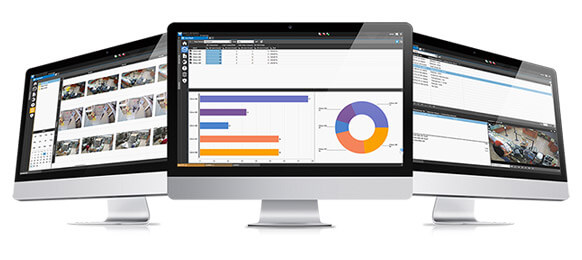In Part 1 of this blog, we looked at some of the practical steps retailers can take to protect their businesses from flash mob theft. In this follow-up, we’ll explore some of the physical security tools available to help you…

Four Points to Consider When Auditing Your Retail Store with Video Surveillance Systems
Retail surveillance systems can help reveal a more complete view of how your business is operating when you’re not there.
Throughout my career in retail loss prevention, I’ve seen some pretty outrageous behavior captured by video surveillance systems. From performance and productivity issues – like employees showing up late and doing personal things on business time – to outright theft from the point-of-sale (POS) system, I’ve seen it all.
As an owner or manager at any level, it’s disheartening to think of what can go on in your business when you’re not there. You do your best to set high standards, but you can’t be there 24/7 to monitor what’s taking place. Most employees do a good job and can be trusted, so it’s even more disappointing when a few people prove otherwise.
Technology beats the bad guys: Find out how by downloading our FREE Special Report, Retail Technology: Electronic Article Surveillance, RFID Inventory Management and Trends in Omni-Channel Retailing
It’s for this reason that many retailers are undertaking operations audits using their video surveillance systems. By reviewing snapshots of video throughout the day, they’re able to get a more complete view of how their business is operating. Video-based operations audits have helped many businesses increase ROI and boost sales, revenues and profit by finding shrink they didn’t know existed. They also uncover operational, compliance, and employee performance issues, which if left unchecked, can impact your brand and reputation.
In my view, video is the best method of acquiring this information since it captures activity that would otherwise go unseen. Video allows you to see your operation as your customers see it, unfiltered, and the way it occurs when no authority figure is present.
If you’re interested in auditing your store with video, there are several options available to you. Some video surveillance companies offer operational audits as a managed service, where they review the video for you based on a list of key performance metrics (KPIs). Others outsource the service to a third-party, while still others offer user-friendly video management software tools that allow you or someone else on your team to manage the audits in-house.
Here are a few things to consider before making your selection:
1) Consider your needs
First and foremost, identify what you’re hoping to achieve with an operations audit. Is it just exception-based reporting with corresponding video that you want to see, or are you also interested in health and safety issues, the quality of your customer service, and how your employees are performing? There are systems available that, in addition to operations audits, integrate POS data with intelligent analytics like queue length monitoring or people counting to help assess speed of service and measure conversion rates. Identify your wish list up front and make sure that your preferred solution is flexible enough to meet your needs.
2) Cover all your bases
Shrink can occur throughout your store, not just at the cash register. Make sure your audit covers all areas of your business and quickly alerts you to signs of trouble. Remember, loss prevention extends beyond transactions. Just consider what the financial impact would be if a food-borne illness originated in one of your stores.
Ensuring proper food safety is possible by monitoring your video surveillance. You can also create alarms and alerts so you can be notified when your refrigerator thermometer reaches or exceeds a certain temperature – something that could threaten not only your wallet but customer safety.
Again, these same tools can be used to detect theft. Receive email notices when your backdoor opens at 3 a.m., or when transactions have occurred when no customer is present at the POS.
In my experience, the most sophisticated thieves won’t leave an obvious trail in your POS system; they’ll cover their tracks by using alternate methods like completing false returns, stealing a key to open the cash drawer or sneaking merchandise out your back door.
3) Who is viewing the video?
If you’re not reviewing your own video, ensure that the person managing that process knows what to look for. If a third-party auditor is just checking off a list of 10 pre-defined KPIs, they may miss other important issues in your stores. For example, if your audits focus on speed of service and cash handling, someone may miss the fact that an employee is cross-contaminating food. It’s essential to ensure your auditor truly understands your operation, and what constitutes good performance and good service, otherwise the process is much less valuable. One recommendation is having a top performer within your organization view the video and evaluate it based on your standards and their proven ability to deliver within your organization.
4) High-quality video makes the difference
There’s no point conducting an operations audit if the images are blurry and you can’t make out what’s taking place in the video. Make sure the solution you select offers clear, high-definition video with the level of detail required for investigations and a successful litigation defense, if needed.
I can tell you from experience that it makes all the difference. I know of one retailer who was facing litigation after a customer slipped and fell inside their store. The injured person alleged the fall was due to a wet floor. But the customer’s allegation was disproven once investigators reviewed evidence captured by the store’s video surveillance systems. Because the images were clear, investigators were able to zoom in and see that the customer was wearing flip flops and had tripped because of her footwear, not because of the floor conditions.
By considering the above points, you’ll be better equipped to decide which type of operations audit best suits your business needs. Remember to do your research, ask questions, and request a live demonstration of the loss prevention software.
This article was originally published in 2016 and was updated September 22, 2016.





This Post Has 0 Comments